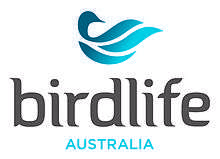BirdLife Australia
BirdLife Australia is the trading name of a company limited by guarantee formed through the merger of two Australian non-government conservation organisations, Bird Observation and Conservation Australia (BOCA) and Birds Australia. A constitution[1] was drafted in May 2011 for BirdLife Australia, which became operational on 1 January 2012. Their respective magazines, the Bird Observer and Wingspan were succeeded by Australian Birdlife.
 | |
| company limited by guarantee | |
| Industry | conservation and research |
| Founded | 2012 |
| Headquarters | Melbourne, Australia |
Key people | Paul Sullivan Chief Executive Officer |
Number of employees | c.75 (2020) |
| Website | birdlife |
History
At simultaneous annual general meetings held on 21 May 2011, the respective members of BOCA and Birds Australia voted to merge and form the new company.[2] Over 93% of those that voted from BOCA voted for the merger and over 95% of those that voted from Birds Australia voted for the merger. A combined total of 4517 Birds Australia and BOCA members voted on the resolution, with over 36% of Birds Australia members and more than 50% of BOCA members voting. This was the biggest response to a proposed resolution that either organisation had ever received.[2]
With the merger, BirdLife Australia became the Australian national partner organisation of BirdLife International, a role hitherto performed by Birds Australia.
The inaugural Board of Directors was made up of five board members from each of the merging organisations, with the addition of a "neutral" chair, Gerard Early - who continues to serve as a Board Member.[3]
The inaugural Chief Executive Officer (CEO), Dr Graeme Hamilton, resigned in October 2012. Dr Hamilton had served as CEO of Birds Australia from 2005 to 2011, and also as CEO of BOCA in its final months of operation in 2011. James O'Connor served as interim CEO from October 2012, until the appointment of Paul Sullivan in January 2013.
Constitution
The constitution of BirdLife Australia is loosely based on the constitutions of the merging bodies. The organisation is member-based, and board members are elected by the membership at an annual general meeting. The constitution also describes a transitional period for the board for its first three years of operation, whereby two members of each original board will stand down at each annual general meeting.
Operations
BirdLife Australia's current national office is at 60 Leicester Street Carlton, Victoria, at the site of the former Birds Australia office. The office of BOCA was in Nunawading, Victoria, and was still owned by BirdLife Australia. The organisation also leases premises at Sydney Olympic Park in Homebush, New South Wales, and Floreat, West Australia. BirdLife Australia owns and operates Gluepot Reserve, a 540 square kilometres (210 square miles) reserve for bird conservation and research in the South Australian semi-arid mallee region, and leases two bird observatories in West Australia, the Broome Bird Observatory and the Eyre Bird Observatory.
BirdLife Australia runs a number of research, monitoring and conservation programs related to Australian birds, and these are often characterised by a significant volunteer input. The Atlas of Australian Birds Project is a national bird monitoring project involving hundreds of skilled bird observers submitting survey data from across the country. This data is used in national reporting, notably State of Australia's Birds reports. Birdata is the gateway to BirdLife Australia data including the Atlas of Australian Birds and Nest record scheme. Datasets from this activity are publicly accessible.[4] Other large scale monitoring and conservation efforts include Shorebirds 2020, a national migratory shorebirds program, and the Beach-nesting Birds program, aimed at improving the conservation status of resident shorebirds through research, adaptive management and community engagement. Other projects, including Birds in Backyards and the Aussie Backyard Bird Count have more of an engagement and education focus. More recently (2017-2019), these projects and programs have been amalgamated into larger programs, including the Urban Bird Program (incorporating the Birds in Backyards program, the Woodland Bird Program (incorporating projects such as Birds on Farms and the Regent Honeyeater Recovery Project), the Coast and Marine Program (incorporating the Beach Nesting Birds program, as well as new programs including the Preventing Extinctions program. These programs are increasingly guided and informed by Conservation Action Planning.
Awards
The organisation awards a number of regular prizes.
The D.L. Serventy Medal may be awarded annually for outstanding published work on birds in the Australasian region. It has been awarded for the last 20 years and is the highest award offered to professional ornithologists by BirdLife Australia.
The J.N. Hobbs medal may be awarded annually for outstanding contributions to Australasian ornithology by an amateur ornithologist.
The Stuart Leslie Bird Research Award and the Professor Alan Keast Award are bestowed annually to postgraduate students of ornithology, with an emphasis on conservation applications.
See also
References
- "BirdLife Australia Constitution" (PDF). Birds Australia. Retrieved 23 July 2011.
- "Dial M for Merger". Birds Australia. Archived from the original on 22 March 2012. Retrieved 16 April 2016.
- "People | BirdLife". www.birdlife.org.au. Retrieved 24 October 2017.
- "BirdLife Australia, Birdata". Atlas of Living Australia.
Further reading
- Robin, Libby. (2001). The Flight of the Emu: a hundred years of Australian ornithology 1901-2001. Melbourne University Press: Carlton. ISBN 0-522-84987-3
External links
| Wikidata has the property: |